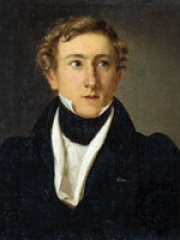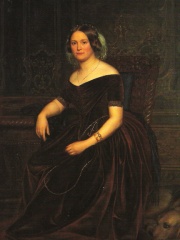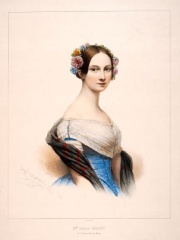


The Most Famous
DANCERS from Denmark
This page contains a list of the greatest Danish Dancers. The pantheon dataset contains 116 Dancers, 3 of which were born in Denmark. This makes Denmark the birth place of the 9th most number of Dancers behind United Kingdom, and Germany.
Top 3
The following people are considered by Pantheon to be the most legendary Danish Dancers of all time. This list of famous Danish Dancers is sorted by HPI (Historical Popularity Index), a metric that aggregates information on a biography's online popularity.

1. August Bournonville (1805 - 1879)
With an HPI of 64.58, August Bournonville is the most famous Danish Dancer. His biography has been translated into 24 different languages on wikipedia.
August Bournonville (21 August 1805 – 30 November 1879) was a Danish ballet master and choreographer. He was the son of Antoine Bournonville, a dancer and choreographer trained under the French choreographer, Jean Georges Noverre, and the nephew of Julie Alix de la Fay, née Bournonville, of the Royal Swedish Ballet. Bournonville was born in Copenhagen, Denmark, where his father had settled. He trained with his father Antoine Bournonville as well he studied under the Italian choreographer Vincenzo Galeotti at the Royal Danish Ballet, Copenhagen, and in Paris, France, under French dancer Auguste Vestris. He initiated a unique style in ballet known as the Bournonville School. Following studies in Paris as a young man, Bournonville became solo dancer at the Royal Ballet in Copenhagen. From 1830 to 1848 he was choreographer for the Royal Danish Ballet, for which he created more than 50 ballets admired for their exuberance, lightness and beauty. He created a style which, although influenced from the Paris ballet, is entirely his own. As a choreographer, he created a number of ballets with varied settings that range from Denmark to Italy, Russia to South America. A limited number of these works have survived. Bournonville's work became known outside Denmark only after World War II. Since 1950, The Royal Ballet has several times made prolonged tours abroad, not the least to the United States, where they have performed his ballets. Bournonville's best-known ballets are La Sylphide (1836), Napoli (1842), Le Conservatoire (1849), The Kermesse in Bruges (1851) and A Folk Tale (1854). Later major ballets include Valkyrien, Thrymskviden, Arcona and Fjedstuen.

2. Louise Rasmussen (1815 - 1874)
With an HPI of 62.55, Louise Rasmussen is the 2nd most famous Danish Dancer. Her biography has been translated into 17 different languages.
Louise Christine Rasmussen, also known as Countess Danner (21 April 1815 – 6 March 1874), was a Danish ballet dancer and stage actress. She was the mistress and later the morganatic wife of King Frederick VII of Denmark. She was not a queen consort, but officially styled Countess Danner.

3. Lucile Grahn (1819 - 1907)
With an HPI of 58.63, Lucile Grahn is the 3rd most famous Danish Dancer. Her biography has been translated into 17 different languages.
Lucile Alexia Grahn-Young (30 June 1819 – 4 April 1907) was the first internationally renowned Danish ballerina and one of the popular dancers of the Romantic ballet era. Grahn studied from a young age at the Royal Danish Theatre School in Copenhagen, Denmark under the tutelage of August Bournonville. She officially debuted in 1834 at the theater and took on the leading role of Astrid in Bournonville's Valdemar in 1835. Soon the relationship between Bournonville and Grahn began to sour as she yearned to dance with the famed Paris Opera Ballet. Grahn reportedly changed some of the steps in Valdemar to show off her footwork, prompting Bournonville to make a formal complaint to the theatre directors. In 1836, she created the title role in Bournonville's La Sylphide. She eventually received royal permission to leave; after her departure in 1836, she never returned to Denmark. In 1839, Grahn had overstayed the terms of her formal leave, and was dropped from the Royal Danish Ballet's rolls. She had been appearing with the Paris 'Opera' Ballet; from 1839 to 1845, extending her audience base, Grahn danced in several cities, including London, St. Petersburg, and Milan. In 1845, her place among the accepted soloists of her day was acknowledged when she was invited to dance Perrot's Pas de Quatre alongside the already famous dancers Fanny Cerrito, Carlotta Grisi, and Marie Taglioni. As the least well-known of the four, Grahn agreed to dance first. After 1846, Grahn toured much of Europe, not only dancing, but also producing several ballets, including a revival of Perrot's Catarina, and even her own play Bacchus et Ariadne. Grahn moved to Hamburg, Germany in 1848 and became so fond of the country that she built a home in Munich. Grahn retired from dancing in 1856 and was married to Friedrich Young. She became ballet mistress from 1858 to 1861 in Leipzig, Germany and from 1869 to 1875 at the Court Opera in Munich. She died in Munich in 1907, and left her generous estate to the city.
People
Pantheon has 3 people classified as Danish dancers born between 1805 and 1819. Of these 3, none of them are still alive today. The most famous deceased Danish dancers include August Bournonville, Louise Rasmussen, and Lucile Grahn.
Deceased Danish Dancers
Go to all RankingsAugust Bournonville
1805 - 1879
HPI: 64.58
Louise Rasmussen
1815 - 1874
HPI: 62.55
Lucile Grahn
1819 - 1907
HPI: 58.63
Overlapping Lives
Which Dancers were alive at the same time? This visualization shows the lifespans of the 3 most globally memorable Dancers since 1700.

